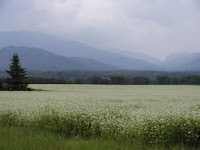
* seeing your name on books at your local bookstore
* sharing your expertise with the world
* having a reader say, "This book changed my life!"
* telling your story
* creative self-expression
Everyone always asks me, How did your first books get published?
I'm a bit of an unusual case. Publishers came to me for my first three book contracts because I was an expert. I owned a natural foods gourmet cooking school. It was reviewed in USA Today.
There weren't many such schools in the early eighties. The first publisher called me up. She was interested in a book about my healthy cooking methods. I wrote it with a lot of help. The book, Healthy Cooking, had all my favorite tips and ideas and great recipes. People loved it. And so did the cooking professionals. To my great delight, it won second place, best cookbook of the year, in the health and diet category of the IACP/Julia Child Awards, the largest awards for food publications. It was also the publisher's best seller that year out of 30 books.
This success led to another book contract. . . and another
At the time, I didn’t ask myself why I wanted to write books. I was busy teaching and the books were a side project I was thrilled to do. Because the benefits were obvious: money and credentials. The books enhanced my career and helped pay my way for several years.
Then I got hooked on writing books!
I began writing other kinds of books (I co-authored Cholesterol Cures, published by Rodale Press, for example). Technical books were similar in format to food books—both were nonfiction, both expert-based. I became a good researcher and interviewer. I wrote about topics I learned about, from my unique research and perspective.
A big life change--and change in my book-writing
Then I had cancer, a business bankruptcy, and a divorce within a short period of time. Life changed!
I used my writing as therapy but I also realized I wanted to share my outlook on life (how to handle such changes and trauma) with a reading audience.
So I pitched a memoir/self-help book to a small publisher and got another book contract.
It was much harder to put together. I had no experience writing in this new genre. When I asked myself why I was writing this book, it was because the experiences I’d lived through were life-changing. I knew others were going through such experiences. I wanted to help.
I had all these stories, all these ideas. A writing friend suggested I try just writing these out, without worrying how to organize them. Even after ten years of book writing, with many published books behind me, I was still stymied by the book-writing process, but her suggestion freed me up from the more rigid outlines I’d used with the food and medical books. A memoir was less rigid, in essence, and I loved the flexibility.
Memoirs also demand much more of you, personally. I had survived many hardships and learned much about the miracle of spiritual community. I wanted to write about this in a book about my life. This genre requires a writer to show up on the page and reveal beliefs, thoughts, weaknesses, failures, victories. I liked all my previously published books, but I hadn’t been as involved in them. I was the expert, I had good information to share, but I didn’t need to be vulnerable on the page.
Doing my homework about the craft of book-writing
I began to speak with other writers who’d published memoirs. What did it take? Most didn’t know. Almost all of them told me the same thing: you sit down in front of the computer, you wait, and you hope for the best.
It sounded too hard. But the memoir idea persisted. Besides, I was hooked now. I liked seeing books on a bookstore shelf with my name on them. I wanted to write more books.
So I wrote. I wrote small snippets. I didn’t worry too much about how they would go together. I photocopied sections of my journal where I’d recorded something that seemed to relate to my book idea.
Two helpful books I discovered along the way
My method was improved when I came across a writing book called A Writer’s Time, by former UCLA creative writing teacher Kenneth Atchity (W.W. Norton and Co., 1995). Atchity called my snippets “islands.” He validated my idea of keeping these islands separate during the exploration of a book idea. Then, after a certain number of words (or islands) was written, structuring could begin.
My snippets were coming from both outer events I’d lived through and also the meaning of these events. I would come to call these the “outer story” of a book and the “inner story.” Soon I came across another writing book that confirmed my grass-roots idea: Vivian Gornick’s The Situation and the Story (New York: Farrar, Straus and Giroux, 2001). Gornick analyzed essays and talked about the important two sides to any good story, whether fiction or nonfiction—the situation or events (what I was calling the “outer story”) and the story underneath those events, their impact or effect or meaning (what I called the “inner story”).
If a writer doesn’t make room for both the outer and the inner world of their book, the book will not touch a reader in a satisfying way.
The story will not linger.












